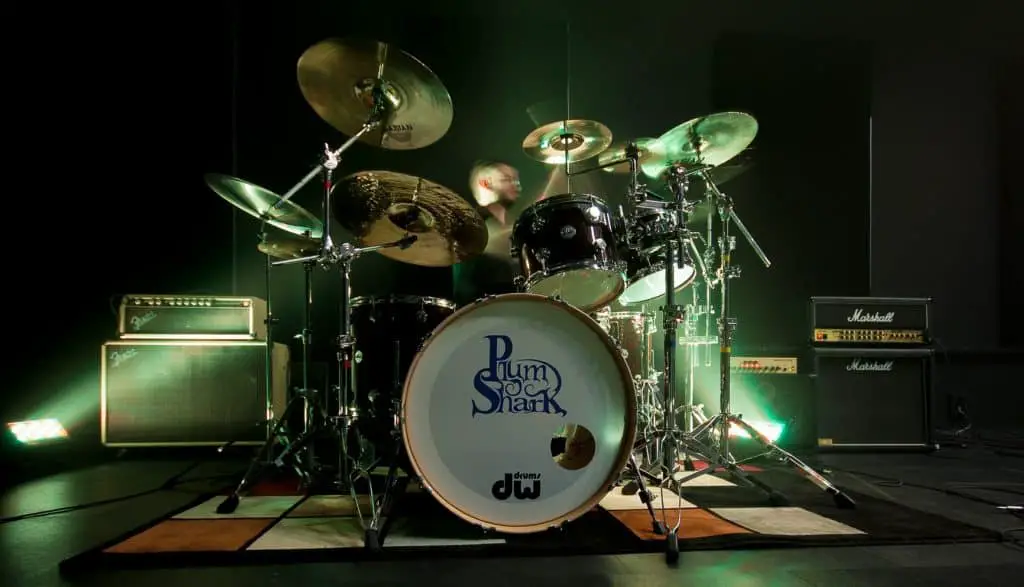
Soundproofing a room from airborne or structure-borne noise is super easy by implementing some basic techniques of soundproofing but if willing to soundproof a room for drum, it will be a bit challenging job.
Do you know, on average drum noise oscillates between 90-130 decibels, which is closely equal to the noise level of the subway train but if you have a bass drum then it will be a bit noisier up to 106 decibels?
So, the noise generated from different other sources will be of less in amplitude or intensity as compared to noise or sound generated from beating a drum and if you are living in an apartment or close society area then you may face an issue from the neighbor.
Taking professional help to design a soundproof drum room may cost you several thousand dollars but I have detailed everything steps by step DIY tips in just 7 simple steps so that you can create your own space for drum practice from any noise.
Generally, while playing the drum the sound or noise originated from the drum will get amplified by reflection from hard surfaces like walls, ceiling, or floor.
Hence the focus should be to absorb the soundwaves and minimize the echoes and also block noise escape from the room.
Now follow the below given simple steps to soundproof a room for drum.
Table of Contents
How to soundproof a Room for Drum
Maybe you are familiar with the concept of noise and sound. Noise is something which is not pleasant to hear, if you are beating a drum in the music studio or auditorium then maybe no one has any complaint about it and this may be pleasing to hear.
But beating the same drum in your apartment can be annoying to hear by a neighbor hence our aim is to absorb all the noise before it gets amplify or escape from the room and this can be possible by implementing some DIY soundproofing or sound-absorbing techniques.
#1: Seal all the Holes, Gaps, and Cracks around the Window and Door
If you have gone through the detailed guide on what is noise and how it travels then you already knew the transmission medium for noise is the displacement of air particles.
If there is any corner from where you found a leak or space which allows air or light to come in then it will also give an obvious opportunity for noise to travel through the same point.
Holes, gaps, or cracks could be generated due to the improper fixing of the window or door with the outer frame. Make sure to check the area around the door or window frame and try to fill the gaps in case it has any.
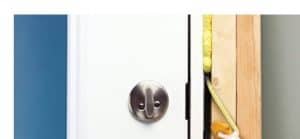
If you are struggling to find ways, where are the exact cracks or holes then try to check at night time by switching off all the lights inside the room and flash the light from the other side of the room.
And try to identify from which area the light is coming in or flashing, Isn’t it simple?
Now the next query you may ask is how to fix holes and cracks?
The suggested solution is to use the best acoustic sealant which is flexible enough and provides an airtight filling to block 100% noise.
But you can try NoiseProofing sealant by Green Glue the which is a bundle of 6 tubes to cover the complete area of the house.
#2: Improve the Window Glazing and seal your Door
The door and windows are the major area in the room which cause soundwaves gets space to pass-through from one side to another hence look around and fix a couple of issues with the door and window.
If you have filled all the gaps and cracks around the frame then this time is to look first with the glass window which is generally of a single layer.
Due to a single layer, it can be thinner in width, so better to install a 2nd layer of glazing on the existing glass layer with a minimum spacing of 6 mm.
Which will increase the barrier and offer strong insulation to soundwaves by having a decoupling zone between the windows layer.

The air space created between both layers of glass will work as an insulator and prevent heat and noise to pass from one side to the other and this could also be your energy-efficient solution.
Soundproofing a window can create a real impact on the sound transmission hence do not miss the 9 tips on how to soundproof a window in the room.
Now let look around the major issues of the door, which probably you have not noticed.
The door will always have space in between the ground and wooden material through which noise gets full freedom to pass from one place to another.

The only thing which can block this is a soundproof door sweep which is easy to fix and a quick solution to block the noise to cross from one side to another.
Door Sweep can have multiple use cases but the most common is to block the noise, light, dust, and insects. If you ask me then M-D Door Sweep is one of my topmost recommendations.
#3: Add Acoustic foam and Bass Traps on Wall or Corners
While you beating the drum cause soundwaves to start from the drum and try to escape from the room but there are few areas like walls which instead of focusing on absorbing soundwaves reflect back to the same or different direction.
Acoustic foams are sound-absorbing materials and their ability to absorb the soundwaves is more than any other material due to the high NRC (Noise reflection coefficient) of the acoustic foams as compared to conventional foams.
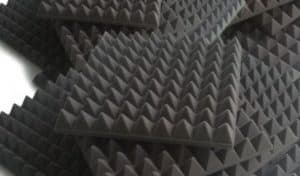
We already explained the types of Acoustic foams and how each acoustic foams works better in different frequencies of soundwaves. If you have gone through the guide then the best possible option for the drum room could be a pyramid Acoustic Foam Panel.
The simple principle is if your room is full of any comfy or soft materials instead of hard surfaces then noise echo will be very less as it absorbs most of the sound waves.
But it is advisable to fill your wall with the best decorated acoustic foams that will not only absorb the soundwaves but also divert them into different directions to minimize the amplification of the noise.
While making a selection of the acoustic foam make sure it has high NRC and in this list, my recommendations would be to try Pyramid Sound Absorption acoustic foam by Fomily.
#4: Cover the door, walls, or windows with a soundproof blanket
We discussed how using door sweep you can block the noise coming from the downside of the door and how using soundproof curtains and double glazing you can increase the absorption or insulation of the sound waves but what if none of the solutions is much effective?
If you are already running out of budget and if I am suggesting you replace the thin door or window with a new one then it could not be an affordable solution then the best possible approach is to use soundproof blankets.
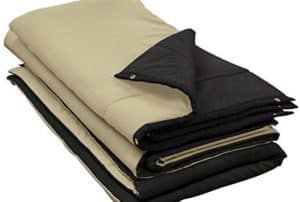
Soundproof blankets are different than conventional blankets which are made of double layers where it’s topmost layer is transparent enough to allow soundwaves to pass in and the internal layer is dense enough to trap or absorb most of the sound energy.
Using soundproof blankets on top of the door can increase the density or mass of the door which in result most of the soundwaves got absorbed or very less reflection.
Well, this is a multipurpose easy solution as this blanket can be easily removed and can be used for carrying the materials from one place to another.
#5: Use SoundProof Rugs underneath the Drum
While you beating the drum the area which got most of the vibrations is the flooring which we call the structure-borne or impact noise.
This type of noise causes vibrations of the flooring and it transmitted to another area of the building and through the air, it converted into the noise.
Such sort of noise can be eliminated using the soundproof rugs or carpets which are heavy enough to reduce the direct impact of the drum with the flooring. If you have read the flooring construction guide then in an apartment, flooring is made of four layers.
- Joist
- SubFloor
- Underlayment
- Floor covering.
Every floor has floor covering in some cases people use tiles or in another carpet on top of the subfloor but the use of an underlayment is optional. If you are looking to soundproof a room for drum then it is strongly recommended to focus on underlayment and floor covering.
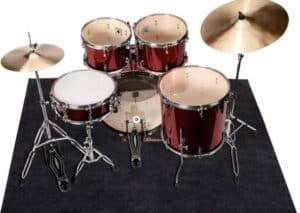
Use of high-density rugs like Meinl Cymbals MDR-BK Drum Rugs (Amazon) which is 6 1/2″ and 5 1/4″ in the dimension has enough coverage and nonslippery bottom made of tightly-woven fabric to give stability and high insulation against the impact noise.
The use of such drum rugs on top of the floor covering can make a huge impact on minimizing the impact of noise and reducing the echos.
Remember vibration cause most of the surrounding get impacted so better to fix this on priority then head over to others if needed.
#6: Use Mass Loaded Vinyl (MLV)
Soundwaves can easily pass through the weak or thin surface, as it transmits by vibrating every material which comes into its transmission way and the only way which can block or prevent further transmission is the mass or density of the material.
It is the basic nature of every material that if it has higher mass then it has higher weight or thickness but the mass loaded vinyl is an exception in all cases which is flexible enough to mold in any shape and its thickness to mass ratio is unbeatable.
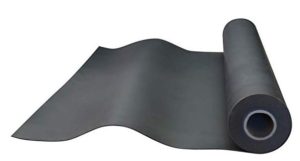
Mass loaded vinyl can be easily installed on the wall or every hard surface as you can use on top of the drywall or back of the soundproofing acoustic foam panels.
This creates a strong barrier for soundwaves which causes very fewer soundwaves will get escape from the room and we can confine the noise within the room. I imagine this could be the best solution for soundproofing a drum room.
To learn more on mass loaded vinyl and how you can use this, I recommend reading through the detailed guide Mass loaded vinyl(MLV) the best effective solution of soundproofing.
It can be stick over any surface especially if your door is not efficient enough or you have a wall with a major cavity in between two rooms.
#7: Create a Room within a Room as Decoupling Zone
Maybe this seems to be familiar with every soundproofing techniques where we plan to isolate our drum room with the actual wall of the room, is it confusing to understand? Don’t worry let me explain.
Decoupling is the most important principle of soundproofing where we try to create an air medium zone between two surfaces, which cause noise coming from one solid surface will get air medium and slow down and then again solid medium to transmit further.
You can create a room within a room using two materials:
- SoundProof Drywalls
- Resilient Channel
This solution could be a bit expensive as here we are planning to build a wall before the existing walls where you have to follow the below steps to have everything in place which is an effective solution, where I consider you already have drywall.
- Remove the existing drywall and find clear visibility of verticle studs.
- Fix the resilient channel on top of the verticle studs.
- Fit drywall using screw-on top of the resilient channel.
In this way, in between the existing wall and drywall, the resilient channel will create at least 1/2″ of air pocket which works as a decoupling zone and attenuate the frequency or amplitudes of the most soundwaves which try to escape from the walls.
If you are spending money on the use of drywall and resilient channel then do not miss to read the detailed guide on how to use the resilient channel for effective results and how to soundproof a wall using drywall.
Now on top of the wall, you can use acoustic foams or mass-loaded vinyl as we discussed earlier to create additional barriers for soundwaves.
Conclusion on Soundproof a Room for Drum
Above suggested all the 7 ways are good enough to answer all the best ways to confine the noise within the room but for further enhancement use the insulations between the verticle studs of the walls.
I advise using the soundproof drywall instead of general drywall which has a sound transmission class (STC) score of more than 50 which is efficient enough to soundproof a room.
If planning to soundproof a room for drum in an apartment then more focus on impact noise as if not eliminated properly then the person living beneath your house can get more than your expected noise.
I have seen many people love to set up a drum room set within the basement if so then in most cases the impact noise would not be the best concern and rest all other explained methods are good enough to create a soundproof room for drum.
Let me know your view and suggestions in the comment box, in case you have implemented any of the above-explained suggestions, this can help our readers to identify the best possible approach.